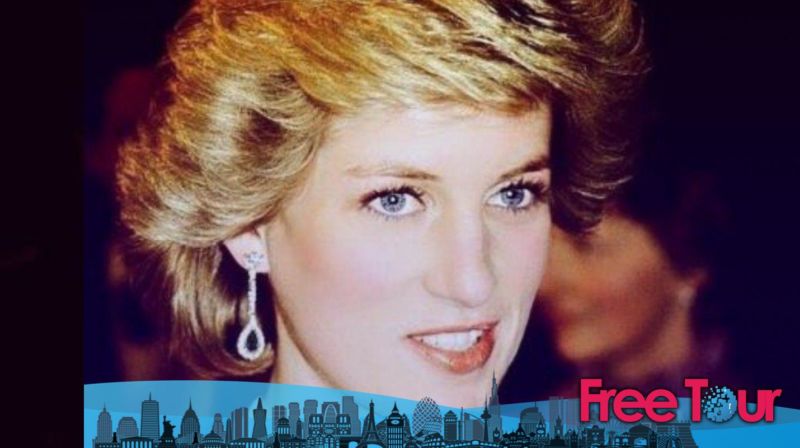Princess Diana, known for her grace and compassion, captured the hearts of millions around the world. As the first wife of Prince Charles, her life was a blend of royal duty and personal struggle, making her an enduring symbol of empathy and resilience.
Throughout her life, Princesa Diana championed various charitable causes, particularly those related to health and social issues. Her legacy remains influential, as she transformed the public’s perception of the British royal family and left an indelible mark on humanitarian efforts globally.

The Life and Legacy of Princess Diana: A Timeless Icon
The life of Princess Diana was marked by her unique ability to connect with people from all walks of life. Born into an aristocratic family, she faced the challenges of being thrust into the limelight as the future queen consort. Her early struggles, combined with her genuine warmth, allowed her to become a powerful voice for the voiceless, often using her platform to advocate for the marginalized and vulnerable.
Among her many contributions, Diana’s work with charities focused on significant issues such as:
- HIV/AIDS Awareness: She played a crucial role in changing public perceptions by openly engaging with affected individuals.
- Children’s Hospitals: Diana worked tirelessly to support children’s healthcare, bringing attention to their needs.
- Landmine Campaigns: Her efforts in raising awareness about landmines highlighted the dangers they pose to civilians.
Diana’s legacy is not only confined to her charitable work; she also transformed the royal family’s public image. Her candidness and approachability helped bridge the gap between the monarchy and the general public, fostering a sense of relatability that continues to resonate today. People remember her not just as a princess, but as a timeless icon of compassion and grace.
Her influence endures through numerous foundations and initiatives that honor her commitment to humanitarian causes. The impact of her work can be felt globally, inspiring future generations to advocate for change and support vital causes. As a result, Princess Diana remains a symbol of hope and resilience, whose spirit continues to inspire countless individuals around the world.
Princess Diana’s Impact on the British Royal Family
Princess Diana’s presence within the British royal family significantly changed its dynamics and public perception. Through her unique ability to connect with everyday people, she brought a sense of humanity to the often distant and formal image of the monarchy. This shift led to a more compassionate portrayal of royal duties, where emotional engagement became a focal point, influencing how future royals interact with the public.
Furthermore, Diana’s candid approach to her personal struggles, including her battle with mental health issues, opened up conversations that were previously taboo within royal circles. Her willingness to discuss these challenges helped destigmatize mental health, prompting both the royal family and society to view such issues with greater empathy and understanding. This legacy continues to inspire initiatives aimed at mental health awareness today.
Additionally, Diana’s style and commitment to philanthropy established a new standard for royal engagement. She prioritized visibility in charitable work, often taking part in hands-on activities rather than merely attending events. This proactive approach can be seen as a precursor to the modern roles adopted by younger royals, who continue to leverage their platforms for social good. Key aspects of her impact include:
- Redefining Royal Duty: Emphasized personal connection and emotional intelligence.
- Advocacy for Change: Addressed pressing social issues, enhancing public trust in the monarchy.
- Creating a Humanitarian Legacy: Inspired future generations to engage in charitable work.
Ultimately, Princess Diana’s impact on the royal family extends far beyond her lifetime. By embodying compassion and challenging traditional norms, she not only transformed the monarchy’s image but also instilled a lasting ethos of service and advocacy that continues to shape the royal family’s mission today. Her legacy is a reminder of the profound influence one individual can have on an institution and society at large.
Exploring Princess Diana’s Philanthropic Endeavors
Princess Diana’s philanthropic endeavors were characterized by her deep commitment to humanitarian causes that addressed some of the world’s most pressing issues. Her approach was not only about raising funds but also about raising awareness, particularly in areas that were often overlooked by society. This dedication has left an enduring impact on various sectors, inspiring both public and private organizations to follow her lead.
One of the most notable aspects of Diana’s charity work was her focus on health-related issues. She became a prominent advocate for:
- Mental Health: Diana was open about her struggles, helping to destigmatize mental health issues and encourage dialogue.
- HIV/AIDS: By visiting hospitals and engaging with patients, she significantly changed public perceptions of the disease.
- Breast Cancer Research: Her support for cancer awareness campaigns helped elevate the importance of early detection and treatment.
Additionally, Princess Diana’s philanthropic legacy is highlighted by her hands-on involvement in numerous charitable organizations. She not only attended events but also participated actively in initiatives that addressed social inequalities. Her proactive approach set a new standard for royal engagement, inspiring future generations to adopt a similar model of involvement.
The impact of Diana’s work can still be seen in the many foundations that continue to operate in her name. These organizations focus on various causes, ensuring that her legacy of compassion and service endures. Through her efforts, Princess Diana transformed the landscape of charity and philanthropy, demonstrating the profound difference one individual can make through dedication and love for humanity.
The Fashion Evolution of Princess Diana: Style Icon
Princess Diana’s fashion evolution is a captivating journey that mirrors her transformation from a shy young woman into a style icon. Initially, she showcased a more traditional and demure wardrobe, aligning with the expectations of royal attire. However, as her confidence grew, so did her sartorial choices, leading her to embrace bolder designs and vibrant colors that reflected her personality and charisma.
Throughout the years, Diana became known for her ability to blend high fashion with accessibility. She often sported outfits from renowned designers such as Versace, Chanel, and Gianni Versace, yet she also mixed in pieces from more affordable brands, making her style relatable to many. This unique combination made her fashion statements not only trendsetting but also approachable, inspiring countless women around the globe.
Some key highlights of Diana’s fashion evolution include:
- Iconic Wedding Dress: Her wedding dress designed by David and Elizabeth Emmanuel became a symbol of romance and fantasy.
- Revenge Dress: The iconic black dress worn to a charity gala post-separation from Prince Charles showcased her boldness and independence.
- Casual Chic: Diana popularized casual looks, such as her signature off-the-shoulder sweaters, blending elegance with comfort.
Ultimately, Princess Diana’s impact on fashion extended beyond her personal style; she became a beacon of modernity within the royal family. Her willingness to break away from traditional norms and experiment with fashion allowed her to connect with people on a deeper level, solidifying her status as a timeless fashion icon. Even today, her influence continues to resonate in the world of fashion, inspiring designers and fans alike.
Unraveling the Mystery of Princess Diana’s Untimely Death
The tragic death of Princess Diana in 1997 sent shockwaves around the world, leading to numerous conspiracy theories and speculations. While the official investigation concluded that her death was the result of a car accident in Paris, many remain unconvinced, pointing to various factors that could suggest foul play. These theories often revolve around the roles of the paparazzi, the circumstances of her relationship with Dodi Fayed, and the alleged involvement of the British establishment.
One of the most discussed aspects of the mystery is the presence of the paparazzi at the scene of the accident. Witnesses reported a relentless pursuit of Diana’s car by photographers, raising questions about whether their actions contributed to the crash. Additionally, the controversial circumstances surrounding her relationship with Dodi Fayed added another layer of complexity, with some theorists suggesting that Diana’s death could have been orchestrated due to her breaking away from royal traditions.
Moreover, the investigation led by the French authorities and later the British inquiry known as Operation Paget concluded that the accident was caused by the driver, Henri Paul, being under the influence of alcohol. This finding, while officially accepted, has not quelled the ongoing debates. Critics argue that the investigation was not thorough enough and that key evidence may have been overlooked, fueling continual speculation about the true nature of her death.
Ultimately, the legacy of Princess Diana is intertwined with the mystery of her untimely passing, leading to ongoing discussions regarding media ethics, royal responsibilities, and the impact of public scrutiny. Her life and tragic end remain a poignant reminder of the complexities surrounding fame and the ramifications it can have, not only on the individual but also on the societal perceptions of the royal family.
Princess Diana’s Influence on Modern Royalty and Society
Princess Diana’s influence on modern royalty has established a new paradigm of engagement between the monarchy and the public. By breaking down barriers and emphasizing emotional intelligence, she set a precedent for future royals to connect with people on a personal level. This approach has encouraged a shift towards more relatable and empathetic royal personas, exemplifying how modern royalty can prioritize community involvement and social responsibility.
In addition to reshaping royal duties, Diana’s legacy has significantly impacted societal views on various humanitarian issues. Her advocacy for mental health, for instance, has paved the way for open discussions in both royal circles and society at large. The ongoing initiatives inspired by her commitment include:
- Mental Health Advocacy: Promoting awareness and understanding of mental health challenges.
- Support for HIV/AIDS Campaigns: Changing perceptions and encouraging acceptance through visibility and compassion.
- Women’s Empowerment: Supporting initiatives that uplift women’s voices and rights globally.
Furthermore, Princess Diana’s approach to charity work has set a new standard for royal philanthropy. Her hands-on involvement and genuine care for the causes she championed inspired a new generation of royals to adopt similar methods. Today, initiatives led by young royals frequently emphasize direct participation and personal connection, continuing Diana’s legacy of compassionate and impactful service.
Ultimately, Princess Diana’s enduring influence can be seen not only in the evolution of the royal family but also in the broader societal shifts she inspired. Her life serves as a powerful reminder of how one individual can create a lasting impact on both an institution and the lives of countless others, reinforcing the importance of empathy and humanitarian efforts in today’s world.






